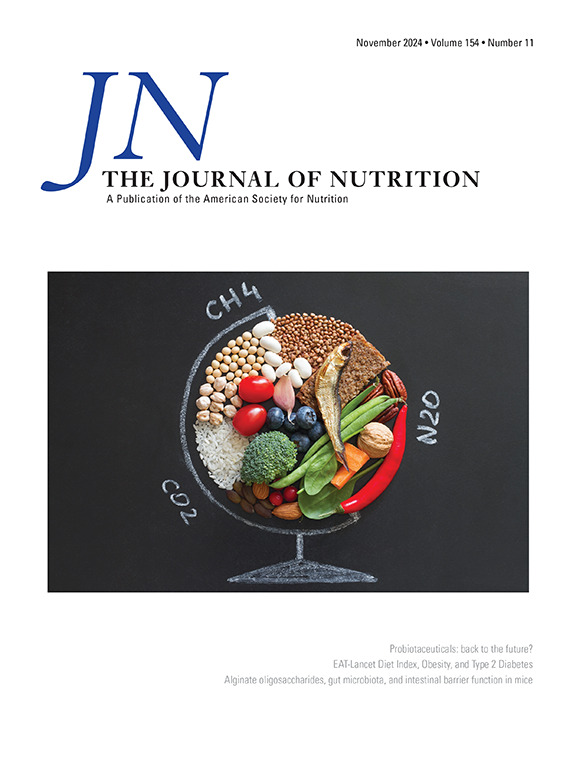在高脂肪饮食中加入整粒或磨碎的干食用豆可以改善肥胖小鼠的骨骼结构。
IF 3.7
3区 医学
Q2 NUTRITION & DIETETICS
引用次数: 0
摘要
目标:豆类作为一种健康饮食成分,含有许多对骨骼有益的成分。本研究调查了在高脂饮食中添加干豆类是否能改善肥胖小鼠的骨代谢:方法:将 4 周大的雄性 C57BL/6 小鼠随机分配到四个饮食组(n=22-24/组),为期 12 周:正常脂肪饮食(NF;4.1 千卡/克,16%的能量为脂肪)、高脂肪饮食(HF;4.9 千卡/克,48%的能量为脂肪)或含有全豆(HFWB)或磨碎豆粉(HFMB)(15% w/w)的高脂肪饮食。含豆膳食的总能量、蛋白质和纤维含量与不含豆的高密度膳食相似。对骨骼结构和相关生物标志物进行了测量。数据采用单因素方差分析,然后进行Tukey-Kramer事后对比分析:结果:与喂食 NF 的小鼠相比,喂食 HFWB 或 HFMB 而不喂食 HF 的小鼠瘦体重更高(P < 0.05,HFWB 和 HFMB 分别为 9.1% 和 8.7%)。喂食 HF、HFWB 或 HFMB 的小鼠的胫骨体积/总体积(BV/TV,P < 0.05)分别比喂食 NF 的小鼠低 23%、14% 和 12%。喂食高纤维素而非高纤维素纤维素或高纤维素纤维素的小鼠,其第二腰椎的骨量/总体积比喂食低纤维素的小鼠低 9.2%(P < 0.05)。与单独饲喂高纤维食物相比,加豆的高纤维食物组的体重、脂肪量、血浆中抗酒石酸磷酸酶、1 型胶原蛋白 C 端端肽、血糖浓度分别增加了 18%、14%、27%、17% 和 15%(P < 0.05)。相对于单独的高频饮食,磨碎的豆粉对体重、脂肪量、胫骨结构模型指数、循环瘦素和血糖的影响大于全豆:这些数据表明,在高脂饮食中添加干食用豆类可减轻肥胖小鼠的骨质退化,但并不能完全防止骨质退化。本文章由计算机程序翻译,如有差异,请以英文原文为准。
Incorporation of Whole or Milled Dry Edible Beans into a High-Fat Diet Improves Bone Structure in Obese Mice
Background
Pulses, a healthy diet component, have many bone-beneficial nutrients.
Objectives
This study investigated whether incorporation of dried pulses to a high-fat diet improves bone metabolism in obese mice.
Methods
Male C57BL/6 mice at 4-wk-old were randomly assigned to 4 diet groups (n = 22–24/group) for 12 wk: a normal-fat (NF; 4.1 kcal/g and 16% energy as fat), a HF (4.9 kcal/g and 48% energy as fat), or a HF containing either whole beans (HFWB) or milled bean flour (HFMB) at 15% wt/wt. Diets containing beans had similar total energy, protein, and fiber content as the HF without beans. Bone structure and related biomarkers were measured. Data were analyzed using a 1-way analysis of variance followed by Tukey-Kramer post hoc contrasts.
Results
Mice fed the HFWB or HFMB but not the HF had higher lean mass than those fed the NF (P < 0.05, 9.1% and 8.7%, for HFWB and HFMB, respectively). Mice fed the HF, HFWB, or HFMB had 23%, 14%, and 12% lower tibial bone volume/total volume (P < 0.05), respectively, than those on the NF. Mice fed the HF but not the HFWB or HFMB had 9.2% lower bone volume/total volume in the second lumbar vertebrae than those fed the NF (P < 0.05). Pooled HF with bean groups had 18%, 14%, 27%, 17%, and 15% greater body weight, fat mass, plasma concentrations of tartrate-resistant acid phosphatase, C-terminal telopeptide of type 1 collagen, blood glucose than the HF alone, respectively (P < 0.05). Milled bean flour had a greater impact on body weight, fat mass, tibial structural model index, circulating leptin, and glucose than whole bean relative to the HF alone.
Conclusions
These data indicate that the incorporation of dry edible beans into a HF mitigates but does not fully prevent bone deterioration in obese mice.
求助全文
通过发布文献求助,成功后即可免费获取论文全文。
去求助
来源期刊

Journal of Nutrition
医学-营养学
CiteScore
7.60
自引率
4.80%
发文量
260
审稿时长
39 days
期刊介绍:
The Journal of Nutrition (JN/J Nutr) publishes peer-reviewed original research papers covering all aspects of experimental nutrition in humans and other animal species; special articles such as reviews and biographies of prominent nutrition scientists; and issues, opinions, and commentaries on controversial issues in nutrition. Supplements are frequently published to provide extended discussion of topics of special interest.
 求助内容:
求助内容: 应助结果提醒方式:
应助结果提醒方式:


